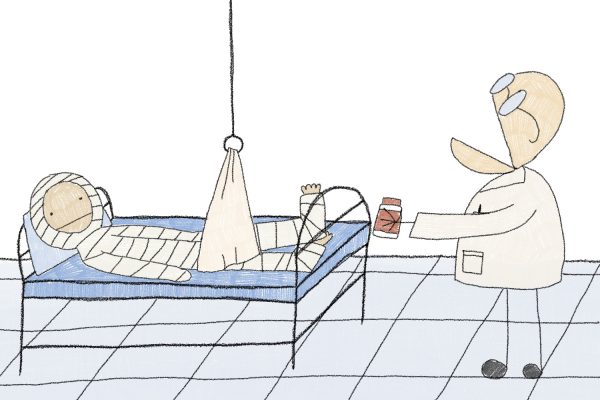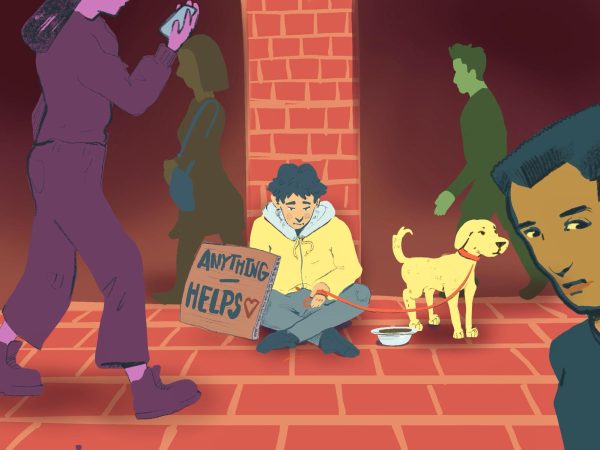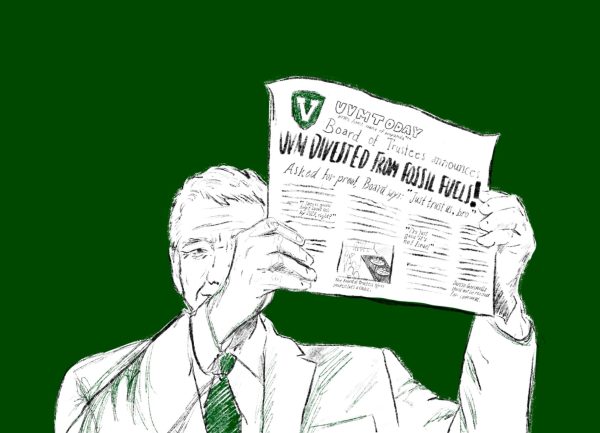Discussing Divestment
October 19, 2019
Chris Harrell: Hello, Cynic friends! Today, my friend Emily and I are talking about divestment.
Emily Johnston: The call for divestment is the call to move investments the school makes away from the fossil fuel industry. Around $27 million of UVM’s endowment is in fossil fuel corporations according to an October 2019 Vermont Cynic article.
UVM promotes itself as a sustainable campus, with composting and a renowned natural resources program. This is why students are calling for divestment; contributing to fossil fuels undermines the green image of the school. Not to mention, the burning and extraction of fossil fuels is a major cause of climate change.
As an eco-rep change agent on campus and an environmental science major, I care about making changes in favor of sustainability. Students have an obligation to do what is in their power to get this institution away from fossil fuels.
C.H.: I have to say that divestment is of special importance to me. I’ve been writing about it for almost a year and am involved in Organize, a student-run organization dedicated to bringing divestment to UVM.
I have a lot to say on the topic, but I want to hear what you think about Richard Cate’s recent statement, and if you think that the University will end up divesting.
E.J.: It is sad to see that the Vice President for Finance does not want to divest. I understand that this decision is most likely due to the fact that the Board of Trustees are against divestment. But, I don’t think the opinions of a select group should dictate what an entire University does.
He says that divesting will not do much, as the investment by UVM is small. What he does not understand is that every action matters in this situation.
Each time a University commits to divesting, the fossil fuel industry loses power.
With diminished monetary power and influence, Congress may not be under the control of coal and oil lobbyists. This can help us stop the gridlock this country has been in since the 90’s.
Focusing on getting students to ride bikes and walk instead of drive is also not the only way to actually do something. Divestment is actually doing something. It should not be up to the individual student to change the carbon footprint of the University. The University is a system, and change works best when it is top-down.
C.H.: I’m obviously pretty heartbroken the University is trying to stomp down the movement before we even get going.
At Organize, we’ve been preparing a proposal on divestment for the Board of Trustees at their upcoming meeting. We’ve been working with SGA, UVM Progressives and like-minded environmentalists to put together the most holistic and complete proposal outlining why we need to divest.
And while the University’s resistance was expected, I honestly thought we’d at least make it to the Board meeting before they told us no.
E.J.: There’s still hope. With the climate strike in late September gathering hundreds of UVM students together, it is clear this campus has a passion for our planet. With repeated protests and petitions, one day the University will divest.
It happened at Middlebury College after six years of student activism. If us Catamounts are as passionate and persistent as our neighbors, we can be able to divest.
C.H.: I see a very close parallel between the fossil fuel divestment movement now, and the apartheid divestment movement of the early 1980’s. Student and faculty groups forced the University to divest from the apartheid South African government.
E.J.: Well, at least they divested then. That’s a good sign that they might eventually give in to our demands for fossil fuel investment. What did it end up taking to get the University to pull the investments then?
C.H.: This isn’t the answer that I’d like to give, or that the University would like repeated, but it took 6 years of student activism to finally get the University to divest.
The process started in 1979. The University didn’t divest until the coalition of students and faculty really got disruptive with their tactics.
They disrupted convocation with protests, staged sit-ins in the University President’s office and within the Waterman building. They threatened to work on legislation to change the Board of Trustees’ makeup and even set up a shanty-town on the Waterman green. The University arrested at least 18 protestors on two separate incidents.
If you ever have the time, I highly suggest watching the documentary about it currently up on YouTube. It’s 10 minutes, and it really shows how much work those activists had to put in to accomplish their goal.
E.J.: Do you think the student and faculty body needs to engage in similar tactics now to succeed? Was the lack of disruptive protests what caused the failure by students to get UVM to divest in 2013?
C.H.: First off, I want to make clear that my views on this are my own, and I’m not representing any student group in saying this.
I don’t want to say that’s the case, and theoretically the board could do an about-face by the time the board meeting comes around, but I’m not optimistic.
There’s a common thread I’ve found in the administration’s response to student demands. They’ll often agree to “think about it.”
Like when NoNames staged their Waterman takeover, the University had already agreed to think about renaming. It was on their agenda. But they were over a year late on delivering what they had promised. The same thing happened during the apartheid protests. At first, they agreed to divest $2.7 million, but left over $4 million invested. Then, the president at the time said that he was okay with divestment, but that it should be over 2 years- rather than the student demand of 6 months.
I’m also really lucky to have had the ability to talk to Jack Hanson, Burlington City Councilor and divestment activist during his time at the University during the initial push of 2012-2014, about the divestment movement and his experience with the Board. He emphasized to me that during his time, the movement was deflated by an attempt from the administration to focus divestment on only coal, and disagreements between the movement’s leadership on whether to support the watered-down proposal or stick to a hard line on complete divestment.
So my big fear here is that we get a symbolic victory. They agree to divest from coal, or they agree to divest by 2025. If they get to kick this down the road, the students who lead the movement graduate, and the sense of urgency that drives these kinds of mass movements gets deflated.
E.J.: I fear it will be moved to 2025 as well. With new buildings on campus being LEED certified and energy use going down by 16% in the past decade, the University is on track to reach their carbon neutral promise by 2025. It seems as if 2025 is a magical year where all environmental problems will be solved, or at least mitigated. So if divestment is not reality now, maybe it will be by 2025.
The only problem with this sentiment is that the clock is ticking and the more we do now, the better. Anything related to the environment is an urgent issue, as inaction only strengthens the adverse effects from climate change. Today we are already facing some effects, an example being less snow in the winter. By 2025, this issue will be magnified, with perhaps almost all snow on the ski hills being fake.
This pattern is the same for all climate issues; they will be bigger and more diverse. Administrators and other people in power will not be able to ignore it. If the whole University does not adhere to the many promises it hopes to live up to by 2025, it cannot be called green. Yes, UVM is working to be more sustainable, but until they divest, they will never be free of fossil fuels. With a growing campus, and a smarter campus, I hope students will be active in their ideologies and stand up for what they believe in. Divestment being one of those beliefs.
C.H.: You’re absolutely right. According to the climate action plan passed by the University in 2010, the entire University is supposed to be carbon-neutral by 2025. The whole friggin’ thing. How do we expect to call ourselves carbon neutral if we’re profiting off fossil fuel extraction? I think the University needs to act less like a corporation and more like an institution of higher education.
Even beyond fossil fuel investments, I’m concerned about UVM’s relationship with TD Bank, which helped finance $360 million of the Dakota Access Pipeline. That’s UVM being okay with Indigenous people having their water dirtied, sacred sites disturbed and land stolen to increasing fossil fuel output for their own profit.
But to end on a more positive note, I really believe that right now is the moment for this change to happen. Climate awareness is absolutely at an all time high, both locally and globally. The climate strike was absolutely huge. Watching that kind of mobilization gives me a lot of hope that we really can do this thing.
And the sheer number of different people and organizations that have sprung up in favor of divestment is encouraging. I’m partial to Organize- everybody there is dedicated to divestment. They’re all incredibly smart and motivated people that make me optimistic about our prospects.
But even if Organize isn’t your thing, Sunrise Movement has a Burlington branch that does amazing work. UVM Progressives are major allies and have given us a lot of help and energy. Also, the Bread and Roses Collective has a section dedicated to environmental justice and SGA has gotten involved.
E.J.: Absolutely. Walking with my fellow undergraduates and graduate students for climate action gave me chills, and it still gives me chills. It is empowering to live and work with people dedicated to climate action. All of the clubs working on this issue and many other issues give me hope. With collaboration between these organizations and a student body dedicated to climate action, we can do anything. We can change the mind of those in charge about divestment.















![Can’t buy me [self] love](https://vtcynic.com/wp-content/uploads/2024/04/self-care-FINAL-600x398.jpg)
